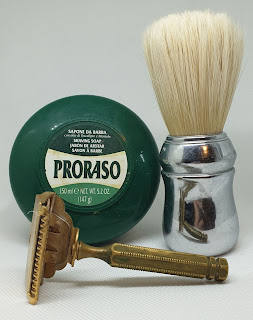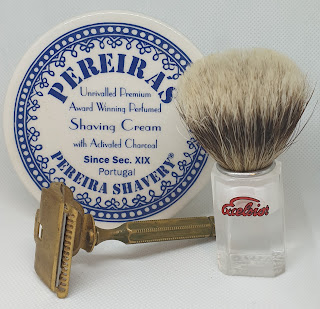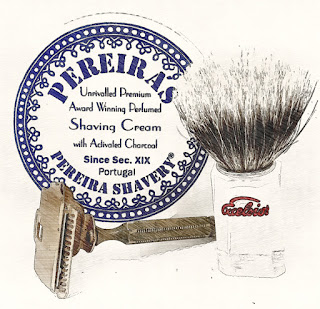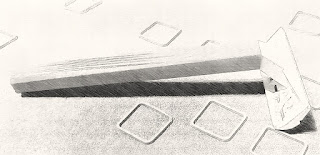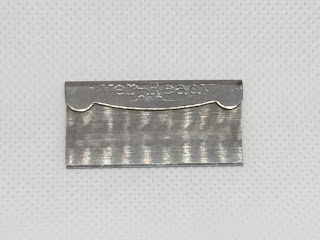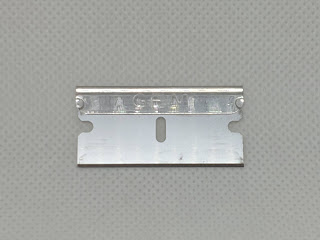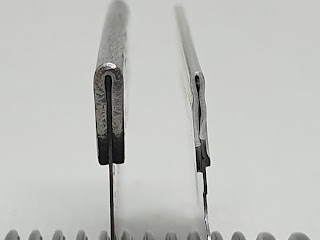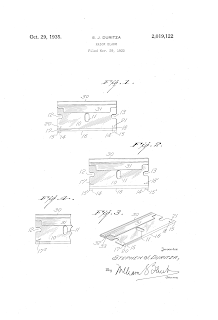Monthly Archives: February 2020
Comitting a book
When I asked a few months back on my favourite shave forum if I should “comitt” a book, the responce was positive… but there was also suggestions for not just making an annotated and commented version of the book I had in mind, but also to publish a collection of my posts discussing and snarking on old patents – solutions in search of a problems, blind roads on the road to the modern shave, but also good idea that simply failed to gain traction for one reason or another.
This is taking shape as a semi-curated selection of important, interesting, inessential, and plain odd shaving related patents – a somewhat serious, somewhat humorous little rump through the patent history of razor and other shaving related accoutrement, and lavishly illustrated with the original drawings from the patent applications and a handful of other pictures used to highlight points being discussed.
The proof copies of “70 razor and shaving patents” have now reached me. This means that if I don’t spot any typos, printing errors or other flaws, it’ll probably be released for sale before Easter.
It will be availabe for Kindle and as a print-on-demand paperback from Amazon. Prices are yet to be finalized… in part because I’m not sure what a good price would be for a 220 page, lavishly illustrated book.
A 1953 GEM advertisement
You can keep the can of goo, but I wouldn’t mind paying just shy of a dollar for a 1953 GEM with ten blades.
Adjusted for inflation, 98 cents would equal a little under ten dollars today. Not a bad deal all told – it’s about what you would have to pay for a modern multi-blade cartridge handle with a couple of cartridges today. Ten GEM blades should last longer than two modern carts though…
Shave of the day 26th February
A 1919 Ever-Ready advertisement
The kit in this ad from 1919 looks a lot like the Ever-Ready 1914 kit I inherited after an old family friend, and which after I learned to use it properly turned into a permanent member of my rotation.
Shave of the day 24th February
Shave of the day 22nd February
Shaving stick with cocoa butter core
Believe that a shaving stick is just a shaving stick? Think again; because in 1919 Mr Joseph Kaufman of the American Safety Razor Corp – the result of the 1906 merger between the GEM and Ever-Ready companies – filed a patent for a shaving stick with new and useful improvements:
The invention relates to a novel stick of shaving soap embodying several features of advantage. The soap contained in the stick I do not modify, except to supply a first class soap therein, but I combine therewith several features of novelty, one being a central vertical core of cocoa butter or equivalent oleaginous substance, another being an elastic casing which normally incloses the stick and which may be rolled downwardly from the outer end thereof as the stick is consumed, another being a rigid base secured to the lower end of the elastic casing upon which the stick may stand vertically, and another residing, in the preferred construction, in a substantially rectangular outline in cross-section of the stick, the corners of the rectangle being rounded.
And that was just the introduction to the patent text… lets break it down, shall we?
The core of cocoa butter or other oleaginous substance1 was intended to combine with the soap to produce a efficient lather for softening the beard and protect the skin – much like many modern soaps sometimes contain cocoa butter, lotions and other skin softening ingredients. Having it as a core instead of mixed into the soap itself would mean that the fat in the cocoa butter wouldn’t react with the alkaline2 when making the soap.
The use of an elastic casing – Mr Kaufman preferred rubber, but listed pyroxylin3 as an alternative – was meant as an alternative to the then common use of tin foil on shaving sticks. The tin foil – according to the patent text – had a tendency to both fall off in patches and to scratch the face of shavers. Another benefit of the elastic casing was that you could roll it back up, protecting the stick and aiding in preserving the original character of the soap and cocoa butter.4
The rigid base – made from metal, fibre or any suitable material – would be cemented to the elastic casing and both aid the stick in standing up and prevent damage to the lower corners of the soap. Mr Kaufaman regarded – according to the patent text – the base an important but not essential part of his invention.
The reasons to have a square-ish – as opposed to round – cross section of the shave stick was quite simple; it would ensure that you had as much exposed soap despite the addition of the core.5 The fact that the shape also meant less wasted space in each box when you packed the shaving stick for shipment isn’t mentioned in the text, but it was one of the first things that stuck me.
While I would love to be able to buy a shave stick like this today, the evolution of shaving soaps have passed it by… today we have skin improving ingredients in the soap itself, the shave sticks are paper covered instead of foil, sticks tends to stand up by themselves or have plastic bases… but they are still round. A square stick would still have benefits, especially when it came to shipping.
1) Oleaginous; rich in, covered with, or producing oil; oily
2) I.e.: lye
3) pyroxylin is nitrocellulose that is less nitrated than, say, gun cotton.
4) I.e.: stop it from going rancid or drying out
5) “…the space occupied by the core of cocoa butter is recompensed for by the additional quantity of soap contained in the rectangular formation”, as the patent text states it
Shave of the day 19th February
The invention of the modern GEM blade, with two interesting variations
The old vintage Ever-Ready and GEM razors from American Safety Razor Corp used a single edged blade different from the GEM blade we can buy today, as can be seen in the photos of one of my old unused – practically NOS – Ever-Ready blades and a fresh GEM blade from my stockpile.
As can clearly be seen the original Ever-Ready/GEM blade was thicker, with a much thicker spine, and had no cutouts. While you can use a modern blade in the original Ever-Ready and GEM razors – such as the 1912 and 19141 – you can’t use the original blade in a slightly more modern GEM, such as the various Micromatics. This is because the more modern razors uses the cutout to align the blade, and a blade without a cutout would stop the razor from closing properly.2
So logic dictates that the change in blade came about the same time as the GEM Micromatic was designed… Say hello to Marcus B Behrman’s patent filed and granted in 1929, describing not only what is in effect the modern GEM blade, but also the double edged single edged GEM blade I wrote about last week and a razor designed to utilise the new blade.
The invention aims primarily to provide a razor blade having special features of construction by the use of which the above mentioned adjustment of the blade with reference to the stops may be carried out with greater effectiveness and certainty, certain additional features of construction being preferably employed in the blade to insure that during assembly it will be preliminarily positioned within the proper range of action of the mechanism employed to press it against the stops.
The invention also includes a novel blade holder adapted to cooperate with a blade of the nature above referred to, to press the blade against the stops as aforesaid.
The function of, and the rationale behind, the cutouts in the blade – which was a radical departure from the original GEM blade – was quite well described in the patent:
To enable the blade to be effectively pressed against stops of the nature above referred to, I will provide it with cut-away portions and 26, located adjacent its opposite side or end edges and rearwardly of its shaving edge, these cut-away portions thereby presenting abutment shoulders 23 and 24 between t e cutaway portions and the shaving edge 20, which may be engaged by properly cooperating movable parts on a blade holder, to press the blade cutting edge against the stops on the holder as aforesaid.
The specific claims for the single and double edged variations of the blades were summarised as:
A safety razor blade having a shaving edge provided with stop engageable corner portions and cutaway portions in the central zone of the blade and in the opposite sides thereof, said cutaway portions presenting abutment shoulders therebetween and said shaving edge, said blade also having an opening between said cut-away portions with elongated linear side walls running transverse to said shaving edge to guide said stop engageable corner portions to their final predetermined stopping position.
A double edged safety razor blade having substantially parallel front and rear shaving edges provided with stop engageable corner portion, and cut-away portions adjacent opposite side edges which present abutment shoulders respectively spaced substantially equally from said front and rear edges, said blade also having an opening disposed substantially centrally between said cut-away portions, said opening being elongated in a direction transverse to said first mentioned edges and having end walls spaced substantially equally from the respective adjacent front and rear edges.
The form and function of the razor is also discussed at great length in the patent, but it’s mostly a variation on the previous GEM razors… the twist to open Micromatics must have been developed somewhat later.
As an interesting aside, a US patent filed for in 19303 also came to the surface as I was searching.
Filed by Stephen J Duritza, the preamble makes no secrets of which razor the new blade was meant for:
My present invention relates generally to razor blades and more particularly to the type of razor in which the shaving edge of the blade is to be received against front aligning stops to give such edge its predetermined position or relationship. Example of such type of razors are those known today as the “Gem” and the “Ever- Ready”.
Interestingly, the reason given for coming up with the new blade design wasn’t to simplify production, improve alignment, or give better shaves.. but to stop the corners from bending:
Where razors of this character are dropped on the floor or brought suddenly against a hard surface, it is generally the corners either of the blade seat or of the clamping cover where such clamping cover is employed, which receives the force of the impact, and may result in the bending of such corners. Where such bent corners engage the blade either at or adjacent to the shaving edge there may be the tendency in such a case for the shaving edge to be distorted from its true straight alignment for its most efficient shaving.
It is one of the objects of my invention to so arrange, treat or construct sections of the blade that this tendency to distortion under these conditions will be minimized or wholly eliminated.
Off course, not dropping your razor in the first place would been preferable – but if you do, it’s nice if you don’t have to replace the blade. What Mr Duritza did to avoid transmitting the shock of impact from the blade stops was to mechanically decouple the edge from the corners with a couple of slits. In the words of the patent:
If this fall results in a deformation of one of the aforementioned parts, this deformation would tend ordinarily to distort the non-functioning section of the shaving edge opposite thereto and this distortion would be transmitted to the active shaving edge. By providing the cuts 17 and 18 as hereinabove explained, the distortion will be taken up by the blade sections 20 or 21 as the case may be and will not be transmitted to the active shaving edge 16.
While the patent that gave rise to the modern GEM blade resulted in production that goes on to this day, Mr Duritza’s patent seems to have gone no where… perhaps the bending of the blade edge from dropping the razor was less of an issue than the inventor believed it to be? The Double Edged GEM blades also seems to have gone the way of the dinosaurs, sadly, but in the days before stainless blades I’m not too surprised about that – by the time you got to flip the blade over, the humidity and soap residue might have done a number on the second edge.
1) It will rattle a little until you close the razor, and a bit of care has to be taken – at least with my 1914 – to make sure it’s aligned properly.
2) This backward compatibility is similar to how you can use a modern slotted double edge blade in an original Gillette Old, but you can’t use a three holed blade in a Gillette Super Speed.
3) not granted until almost five years later though; the wheels of bureaucracy turns slowly at times.





